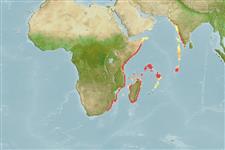Teleostei (teleosts) >
Pleuronectiformes (Flatfishes) >
Paralichthyidae (Large-tooth flounders)
Etymology: Pseudorhombus: Greek, pseudes = false + Greek, rhombos = paralelogram (Ref. 45335).
Environment: milieu / climate zone / depth range / distribution range
Ecology
Marine; demersal; depth range 60 - 260 m (Ref. 4417). Tropical
Western Indian Ocean: known only from Natal, South Africa and southwest India, but probably more widely distributed.
Size / Weight / Age
Maturity: Lm ? range ? - ? cm
Max length : 26.5 cm TL male/unsexed; (Ref. 55634); max. published weight: 175.00 g (Ref. 55634)
Dorsal spines (total): 0; Dorsal soft rays (total): 68 - 72; Anal spines: 0; Anal soft rays: 52 - 55. Eyed side with about 5 longitudinal rows of dark rings; median fins with a row of small dark spots; dark spot near margin of pelvic fin (eyed side).
Inhabits sandy and muddy bottoms.
Life cycle and mating behavior
Maturity | Reproduction | Spawning | Eggs | Fecundity | Larvae
Distinct pairing (Ref. 205).
Nielsen, J.G., 1984. Bothidae. In W. Fischer and G. Bianchi (eds.) FAO species identification sheets for fishery purposes. Western Indian Ocean fishing area 51. Vol. 1. FAO, Rome. pag. var. (Ref. 3322)
IUCN Red List Status (Ref. 130435: Version 2024-2)
Threat to humans
Harmless
Human uses
Fisheries: commercial
Tools
Special reports
Download XML
Internet sources
Estimates based on models
Preferred temperature (Ref.
123201): 18.1 - 24.6, mean 21.1 °C (based on 28 cells).
Phylogenetic diversity index (Ref.
82804): PD
50 = 0.5000 [Uniqueness, from 0.5 = low to 2.0 = high].
Bayesian length-weight: a=0.00631 (0.00393 - 0.01013), b=3.04 (2.91 - 3.17), in cm total length, based on LWR estimates for this species & Genus-body shape (Ref.
93245).
Trophic level (Ref.
69278): 3.5 ±0.4 se; based on size and trophs of closest relatives
Resilience (Ref.
120179): High, minimum population doubling time less than 15 months (Preliminary K or Fecundity.).
Fishing Vulnerability (Ref.
59153): Low vulnerability (17 of 100).
Nutrients (Ref.
124155): Calcium = 171 [77, 352] mg/100g; Iron = 1.08 [0.49, 2.02] mg/100g; Protein = 16.9 [14.8, 19.0] %; Omega3 = 0.171 [0.082, 0.355] g/100g; Selenium = 70 [32, 161] μg/100g; VitaminA = 15.5 [4.1, 59.4] μg/100g; Zinc = 0.88 [0.57, 1.33] mg/100g (wet weight);
